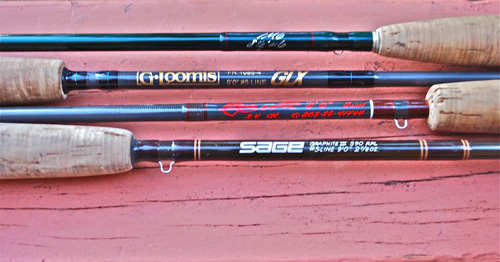Retro Rod Review: Four Graphite Models that Changed the Fly Fishing World

Four retro freestone classics
In marketing-speak, we’ve been through so much “next generation” graphite hype in the last 20 years that, if you actually buy the hyperbole, you might just think a rod made in the mid-1990s is virtually unfishable.
That is, of course, utter hogwash. No matter what anyone tells you, fly rods have not, in fact, evolved at the same techno-pace as things like digital cameras, laptop computers, and cell phones.
A rod is still a rod, and in some cases, some graphite “classics” still have a look and feel that cannot be replaced, even by the very manufacturers that shelved these models in favor of the “faster, lighter” brands they replaced them with.
It’s like driving a classic Ford Mustang, Chevy Corvette, or even a Jeep CJ-7. There’s inherent beauty in the standard. And there’s still inherent beauty in some fly rods that cost a whopping $350, or $450 when they were introduced back in the day.
If you can find one of these on EBay, sold second-hand, at a garage sale, or maybe have one willed to you by its former owner—hang onto it. It’s the real deal.
Sage 590 RPL
I remember begging and pleading with my wife to let me buy a Sage RPL, some 20 years ago. The sticker shock hit both of us—over $350 for a fly rod. Blew my mind at the time, but I bit the bullet. The Sage RPL is the model that got many anglers thinking and feeling beyond anything Orvis had to offer. It’s still a steady performer; not too fast, by modern standards, but not sluggish by any means. It’s still an honest rod, with plenty of backbone and casting punch. This is the rod that taught me to cast, and I still fish it in a variety of situations, east and west.
G.Loomis GLX 9’5”
This is really the rod that changed everything. When G.Loomis developed GLX, the graphite world shifted forever. By modern standards, the original GLX models seem a bit “tippy” for many anglers, but the spine and punch factors were (and still are) impossible to ignore. GLX is the graphite recipe that added distance to the cast, in saltwater and freshwater, and if you know how to handle a GLX rod, the accuracy and distance factors still cannot be replicated, no matter what you throw.
Scott G
I won an original Scott G Series 3-weight, two-piece fly rod at a charity auction, years ago. I was immediately smitten by the design—those internal-fitting ferrules, clean wraps, and the snappy balance that extended from the tip right through the handle and reel seat. Over the years, I have seen and fished with many, many rods, but for small- to mid-sized waters, especially in dry-fly situations, I’ve never seen anything that tops the Scott 8-foot, 3-weight original G series. It’s a classic.
Winston IM-6
Nobody did IM-6 graphite better, with more sex appeal (by way of the rod finish, components, etc.) than Winston did. I remember being on a book (Castwork) trip, in Montana, in September when the hoppers were jumping and the wind was ripping. I paid cash for my part of the hotel expenses with my book partners, so I could pay cash (and hide the purchase from my wife) for a Winston 8’-6” #6 weight rod, which I bought at George Anderson’s shop. My guide at the time, Rusty Vorous, gave it a shake, and exclaimed, “It’ll march.” It’s been marching ever since, and is still my favorite hopper/streamer rod for big water.
This might come as a relief to some of you, but age is not a detriment, even in the graphite fly rod realm. There are some things that may have been forgotten, but in truth, have never been replicated.
You have more resources now than ever to find the classics and put them in your arsenal. And if you have these rods in your quiver already, for goodness sake, don’t neglect them.
Hype is hype, and what works, works. Understanding the difference and knowing when to appreciate a gem already in hand is a very, very good thing.











